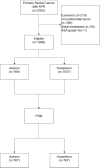Prognostic impact of tumor location after abdominoperineal resection of rectal cancer: A single-center propensity score matching analysis based on 1806 cases
- PMID: 40205263
- PMCID: PMC11982106
- DOI: 10.1007/s10151-025-03114-6
Prognostic impact of tumor location after abdominoperineal resection of rectal cancer: A single-center propensity score matching analysis based on 1806 cases
Abstract
Background: Randomized controlled trials have revealed that abdominoperineal resection leads to inferior oncological outcomes compared with low anterior resection, especially regarding local recurrence rates (LRRs). While neoadjuvant chemoradiotherapy can lower LRRs, it is linked to potential short- and long-term radiation-induced adverse effects. Consequently, meticulous patient selection for neoadjuvant chemoradiotherapy is imperative to balance benefits and risks.
Methods: This research encompassed individuals with rectal cancer (RC) who underwent abdominoperineal resection (APR) from January 2006 to December 2017. The cohort was categorized into two cohorts on the basis of tumor location: the anterior cohort and the nonanterior cohort. Propensity score matching (PSM) was employed to mitigate selection bias, and this resulted in 767 patients in both cohorts. The primary endpoint assessed was survival without local recurrence (LR).
Results: Of the 2025 cases examined, 1806 were deemed eligible for inclusion. In the entire cohort, the incidence of LR was 9.9% (178/1806); the anterior cohort exhibited a higher rate of LR (15.2% versus 5.9%, p < 0.001). Multivariate examination revealed that anterior location was an independent risk factor (IRF) for LR (hazard ratio [HR] = 2.503, p < 0.001). In patients with stage II/III or T3/4, anterior location persisted as a predictor of increased LR. Neoadjuvant chemoradiotherapy for stage II and III tumors diminished the LR rate in anterior tumor locations (p = 0.017) but not in nonanterior locations (p = 0.390).
Conclusion: Anterior tumor location is an IRF for LR in RC patients. Tumor location can serve as a criterion for patient selection in neoadjuvant chemoradiotherapy.
Trial registration: The studies involving human participants were reviewed and approved by the National Cancer Center's Institute Research Medical Ethics Committee (23/180-3922, 11 May 2023). A copy of the written consent is available for review by the Editor-in-Chief of this journal on request.
Keywords: Abdominoperineal resection; Neoadjuvant chemoradiotherapy; Rectal cancer; Tumor location.
© 2025. The Author(s).
Conflict of interest statement
Declarations. Conflict of interest: The authors declare no competing interests. Ethics approval and consent to participate: The studies involving human participants were reviewed and approved by the National Cancer Center’s Institute Research Medical Ethics Committee (23/180-3922, 11 May 2023). Prior written informed consent was obtained from all study participants. Consent to publish: Not applicable. Informed consent: All participants provided informed consent prior to their participation.
Figures





Similar articles
-
Influence of tumor location on short- and long-term outcomes after laparoscopic surgery for rectal cancer: a propensity score matched cohort study.BMC Cancer. 2020 Aug 14;20(1):761. doi: 10.1186/s12885-020-07255-9. BMC Cancer. 2020. PMID: 32795280 Free PMC article.
-
Effect of Tumor Location on Outcome After Laparoscopic Low Rectal Cancer Surgery: A Propensity Score Matching Analysis.Dis Colon Rectum. 2022 May 1;65(5):672-682. doi: 10.1097/DCR.0000000000001965. Dis Colon Rectum. 2022. PMID: 35394940
-
Short- and long-term outcomes of laparoscopic versus open abdominoperineal resection for rectal cancer: A propensity score matching analysis based on 1852 cases.Dig Liver Dis. 2025 Apr;57(4):908-914. doi: 10.1016/j.dld.2024.12.027. Epub 2025 Jan 20. Dig Liver Dis. 2025. PMID: 39837742
-
Abdominoperineal Resection for Rectal Cancer in the Twenty-First Century: Indications, Techniques, and Outcomes.J Gastrointest Surg. 2018 Aug;22(8):1477-1487. doi: 10.1007/s11605-018-3750-9. Epub 2018 Apr 16. J Gastrointest Surg. 2018. PMID: 29663303 Review.
-
Risk factors for local recurrence following neoadjuvant chemoradiotherapy for rectal cancers.World J Gastroenterol. 2013 Aug 28;19(32):5227-37. doi: 10.3748/wjg.v19.i32.5227. World J Gastroenterol. 2013. PMID: 23983425 Free PMC article. Review.
References
-
- Heald RJ, Moran BJ, Ryall RD, Sexton R, MacFarlane JK (1998) Rectal cancer: the Basingstoke experience of total mesorectal excision, 1978–1997. Arch surg 133(8):894–9 - PubMed
-
- Kapiteijn E, Putter H, van de Velde CJ (2002) Impact of the introduction and training of total mesorectal excision on recurrence and survival in rectal cancer in the Netherlands. Br J Surg 89(9):1142–1149 - PubMed
-
- Banwell VC, Phillips HA, Duff MJ, Speake D, McLean C, Williams LJ et al. (2019) Five-year oncological outcomes after selective neoadjuvant radiotherapy for resectable rectal cancer. Acta oncologica (Stockholm, Sweden) 58(9):1267–1272 - PubMed
-
- Dassanayake BK, Samita S, Deen RY, Wickramasinghe NS, Hewavisenthi J, Deen KI (2011) Local recurrence of rectal cancer in patients not receiving neoadjuvant therapy—the importance of resection margins. Ceylon Med J 56(4):159–161 - PubMed
Publication types
MeSH terms
Grants and funding
LinkOut - more resources
Full Text Sources
Miscellaneous

